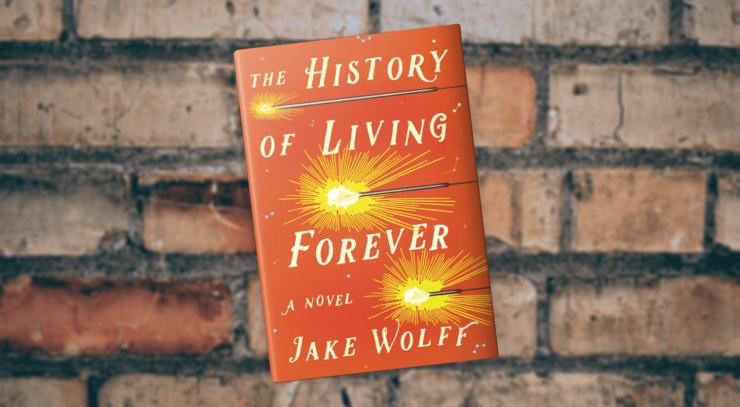The search for immortality is not a thing of the past. From medieval alchemists to Big Pharma, from ancient Chinese medicine to modern nanotech, our quest has never really stopped. Sixteen-year-old Conrad Aybinder is just a part of this storied tradition. When his teacher and lover, Sammy Tampari, dies under mysterious circumstances, he leaves Conrad his legacy: twenty-two journals, a storage unit full of chemistry equipment, and a recipe for the elixir of life.
Jake Wolff’s debut novel, The History of Living Forever is an ambitious and emotionally raw thing, starting and ending with grief, with a twisting alchemical plot tying these human moments together. Its pages jump between Conrad’s youth and Sammy’s, histories of scientific discovery, and an older Conrad, reflecting on all of this and dealing with his beloved husband’s cancer diagnosis. Each point of view invariably asks the same questions: Will we find the elixir? Is it even possible? What sacrifices will we make to cure the very things that make us human?
The novel’s primary plot line follows Conrad as he attempts to recreate Sammy’s elixir, slowly but surely discovering not only the ingredients, but elements of Sammy’s life as well. Conrad may not want to live forever, but his father is dying of liver disease, and he’s convinced that Sammy left him the recipe for a reason. Conrad’s search begins to mirror Sammy’s own: slotting together scientific theories in real time, and even encountering the same people: Sadiq, a scientist and Sammy’s former lover; Catherine, anthropologist and ex-girlfriend; and a whole host of less-than-savory characters from drug kingpins to pharmaceutical execs. All of them have been pulled into Sammy’s irresistible orbit, and all of them have sought the elixir in some form or other. Unlike the others, though, Sammy seems to have found the answer, if only Conrad can piece together the clues he left in his wake.
There’s a lot to be said about this novel’s treatment of science—from its ambiguity between fantasy and reality (do not try these recipes at home, an author’s note warns us) to its treatment of modern healthcare technology as alchemical tradition. However I want to talk about this book primarily as a story about queerness.
And so we might as well start with the elephant in the room: for all this book’s marketing about the power of love, its central love story is one of pederasty. Sammy is an adult man—a teacher and authority figure, no less—in a relationship with a sixteen-year-old high school senior. The book frames this in a rather complex way: an adult Conrad reflects on their relationship, trying and failing to see it as abusive as his therapists and husband argue. He was, after all, in love with Sammy. Regardless of whether that love was returned, and regardless of Sammy’s lies and strangeness in pursuit of the elixir, nothing will change the fact of Conrad’s experiences, or that Sammy left his research to Conrad in the hopes of saving his father. “To recognize the wrongness of a thing,” Conrad confides, “is not the same as to experience it as wrong.”
Buy the Book


The History of Living Forever
So much about the novel, though, is about mental health and trauma. Sammy’s entire search for the elixir is predicated not on living forever, but on curing his depression. His constant refrain—throughout his search, throughout his years of medication and electroshock therapy—is “What is wrong with me?” It’s obvious, though we never see Conrad through his perspective, that he senses something similar in Conrad. Their relationship, then, is not just about love or sex or power. It is instead framed it in the cultural practice of young queer people, especially men, seeking out older mentor figures for relationships, attempting to find someone—anyone—that understands and can guide them through what they’re experiencing.
Queerness is central to The History of Living Forever, and not just because of Sammy and Conrad’s relationship; it is also central to the search for a cure. This desire to be fixed, to be cured of one’s brokenness—Conrad seeks these feelings in Sammy, and Sammy seeks them in the elixir. Sammy’s quest may not be motivated to cure himself of his queerness as such, but it seeps into everything he does: a quest to feel unbroken, to sit right with the world and be considered mentally-well. It’s no mistake that the novel’s climactic scene takes place in an abandoned gay conversion camp. Sammy and Conrad are drawn together in part because they both feel rejected by the world, and it’s no wonder.
This framing of the elixir as a quest not only for immortality, but for normalcy and belonging, is unique amongst the host of alchemy-based SFF I’ve read and seen. It turns the question of “the cure” on its head—if mortality is something no human can escape from, so too are our positions as outsiders, as queers, as mentally-ill, as “broken.” And, the book seems to argue, that can be as painful as it is immutable as it is beautiful. If there’s one thing The History of Living Forever doesn’t offer, it’s an easy answer. It is, after all, not a catch-all elixir.
The History of Living Forever is a page-turner in all its mysteries, both scientific and psychological. It’s the kind of book you think of long after you’ve finished it, whether you liked it or not—and I did like it. I suspect some will be upset by the novel’s central romance, and that’s understandable. But its project is a nuanced one, emotionally real even if it’s not morally inspiring. It’s very worth mulling over.
The History of Living Forever is available from Farrar Straus & Giroux.
Em Nordling reads, writes, and manages research in Louisville, KY.











I loved this book too! For such serious, sad topics it had so much humour. The historical recipes for the elixir were bananas!